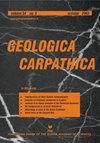Syn-sedimentary and early deformation structures as indications for Jurassic pre-orogenic deformation in the SW Bükk Mts.
IF 1.5
4区 地球科学
Q4 GEOSCIENCES, MULTIDISCIPLINARY
引用次数: 1
Abstract
Detailed fieldwork was carried out in the SW Bükk Mts. at six locations in order to understand the Jurassic pre-orogenic deformation. All localities expose Middle Jurassic oolitic limestones with grains probably derived from the Adriatic Carbonate Platform and therefore from the Dinaridic passive margin of the Neotethys Ocean. Results of the structural analysis revealed early, soft-sedimentary deformation structures. The observed small-scale normal faults are characterized by rounded, curved shapes without any discrete fault planes (sealed faults) and the displaced beds often thicken towards the faults. These faults were interpreted as syn-sedimentary/syn-diagenetic faults, meaning that the deformation took place in unconsolidated or semi-consolidated sediments. During the early diagenetic silica mobilization, the already-present early faults may have served as conduits of silica-rich fluids, which led to the formation of planar silica injection dykes. Sedimentary slump folds were also identified based on the presence of underlying detachment slip surfaces and the observed thickness changes and onlap surfaces within the folded layers. The significance of these early normal faults and slump folds is that they are the first direct evidence for pre-orogenic deformation in the Bükk Mts. The overall structural data suggest NE–SW or NNE–SSW striking early faults and SE to S verging slump folds in the present-day coordinates. By reconstructing the Cenozoic rotations of the Bükk Mts. this means a roughly NW–SE striking original margin and a south-westward facing paleoslope for the Middle Jurassic. Considering the paleogeographic setting of the Adriatic Platform, this paleoslope direction is possible if the deposition area was located above a deeply submerged tilted normal fault block or alternatively, along the landward side of a larger intraoceanic high. The extensional structures may indicate that the Bükk Mts. were closer to the passive margin than the already ongoing intra-oceanic subduction and related trench, all governed by compression.作为SW Bükk Mts侏罗纪造山前变形迹象的同沉积和早期变形构造。
为了解侏罗系造山前变形,在西南段 kk山6个地点进行了详细的野外考察。所有地点均暴露出中侏罗世鲕粒灰岩,其颗粒可能来自亚得里亚海碳酸盐岩台地,因此可能来自新特提斯洋的Dinaridic被动边缘。构造分析结果揭示了早期的软沉积变形构造。观测到的小尺度正断层以圆形、弯曲的形状为特征,没有任何离散的断层面(封闭断层),位移层往往向断层方向加厚。这些断裂被解释为同沉积/同成岩断裂,这意味着变形发生在未固结或半固结的沉积物中。早成岩过程中,已存在的早断层可能成为富硅流体的输送通道,形成平面型注硅岩脉。根据下伏滑脱滑面的存在以及观察到的褶皱层厚度变化和上覆面,确定了沉积滑塌褶皱。这些早期正断层和滑塌褶皱的意义在于,它们是 kk山系造山前变形的第一个直接证据。总体构造资料表明,在现今的座标上,北东-西向或北北-南南向的早期断裂和东南-南向的滑塌褶皱。通过重建 kk山脉新生代的旋转,表明中侏罗世的原始边缘大致为西北-东南走向,古斜坡面向西南。考虑到亚得里亚海地台的古地理背景,如果沉积区位于一个深埋的倾斜正断块之上,或者沿着一个较大的洋内高压的向陆侧,则可能存在这个古斜坡方向。伸展构造可能表明,与已经在进行的洋内俯冲和相关海沟相比,b kk mms更接近被动边缘,所有这些都受挤压控制。
本文章由计算机程序翻译,如有差异,请以英文原文为准。
求助全文
约1分钟内获得全文
求助全文
来源期刊

Geologica Carpathica
地学-地球科学综合
CiteScore
2.40
自引率
23.10%
发文量
26
审稿时长
>12 weeks
期刊介绍:
GEOLOGICA CARPATHICA covers a wide spectrum of geological disciplines including geodynamics, tectonics and structural geology, volcanology, stratigraphy, geochronology and isotopic geology, karstology, geochemistry, mineralogy, petrology, lithology and sedimentology, paleogeography, paleoecology, paleobiology and paleontology, paleomagnetism, magnetostratigraphy and other branches of applied geophysics, economic and environmental geology, experimental and theoretical geoscientific studies. Geologica Carpathica , with its 60 year old tradition, presents high-quality research papers devoted to all aspects not only of the Alpine-Carpathian-Balkanian geoscience but also with adjacent regions originated from the Mediterranean Tethys and its continental foreland. Geologica Carpathica is an Official Journal of the Carpathian-Balkan Geological Association.
 求助内容:
求助内容: 应助结果提醒方式:
应助结果提醒方式:


